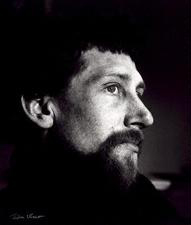| |
|
Abstract
This paper presents the life, work, and context of British sculptor
Peter King (1928-1957). His untimely death meant that he has been largely
omitted from the history of 1950s British art, but recent discoveries
of missing works, diaries, photographic plates, and other memorabilia
indicate the significance of his work for the period. He was undoubtedly
a prolific artist, whose exceptional talent was recognised by Henry
Moore, who appointed him as his assistant along with Anthony Caro. King
was part of a group of artists associated with Moore’s studio,
with the teaching team at St Martin’s School of Art, with artists
living at the Abbey Art Centre in London, and with Victor Musgrave’s
Gallery One in Soho. He received the Boise Travelling Scholarship and
funding from the BFI for an animated film, and exhibited the film and
his work across Europe before succumbing to a blood-poisoning at the
age of twenty-nine.
In his short life, from 1927 to 1957, Peter King completed
a prodigious quantity of sculpture and works on paper. His trajectory
moves, after study at Wimbledon School of Art, from ‘academic’ sculptural
works and public monumental commissions, through very contemporary forms
of abstraction, to a quite destructive fluidity of form in his last
months. After the chaos of his last few years he left behind a widow
with two children and a mistress and son, who between them kept safe
a significant proportion of his collection.
[1]
Many works had been sold to private collectors, and
to the Arts Council, the British Council, and the Contemporary Arts
Society.
[2]
Many more works were destroyed, the bulk of these
scattered in the grounds of the seminal Abbey Art Centre artists’ commune
in High Barnet, London, which either rotted away, were stolen,
or – quite probably – landed up on the popular 5th November communal
bonfire. King as an artist largely disappeared from public and critical
view after his death.
It is only recently, with archival material
emerging from private sources, and from archives at TateBritain and
the Henry Moore Institute, Leeds that
the true picture of King’s place in British art of the 1950s is beginning
to emerge. The Henry Moore Institute has a collection of Peter King
memorabilia, donated, along with several of his works, by his widow
in 2002, while the British Museum
recently purchased several works on paper. Scholarly interest is growing,
and his name has appeared in recent publications.
[3]
In 2003 the Museum
of London showed his film The Thirteen Cantos of Hell, as part of a celebration of London artists’ quarters,
and King is mentioned in the accompanying book.
[4]
In 2004 Ian Barker, having drawn on the Henry Moore
Institute archive, made eight references to King in his volume on Anthony
Caro,
[5]
and in 2007 there were three references in a Henry
Moore Foundation book on Hoglands.
[6]
Most notable to date is the essay by Martin Harrison
in the Henry Moore Institute 2003 two-volume series on British sculpture.
[7]
In it Harrison describes King’s early monumental
work for Giudici stone-carvers, his appointment as assistant to Moore,
his first one-man shows at Gallery One, and the final anguished, dripped
and spattered head-forms created shortly before his death. Exhibitions
including works by King are now taking place on a regular basis.
[8]
As noted by the Museum
of London, King was embedded
in Soho, the creative quarter of London
in the 1950s.
[9]
Through its galleries, through St Martin’s where
he taught from 1953, and through his employment at Moore’s
Much Hadham studios, he came to know many of the key artists, curators,
and collectors of the time. He knew the artists of the New
Aspects of British Sculpture pavilion at the 1952 Venice Biennale.
[10]
This is remembered in terms of Herbert Read’s catalogue
essay, which introduced the term ‘the geometry of fear’, a term that
might usefully be applied to some of King’s work. In a private letter
Frank Martin, who hired King to teach bronze-casting at St
Martin’s, said that King ‘stood alongside the rest of my
team at that time, all emerging sculptors: Caro, Paolozzi, Frink and
Clatworthy.’
[11]
At Hoglands, Moore’s home and studio, King worked
with Caro, Alan Ingham and Peter Atkins. One of the major projects that
he worked on was the far-right of four enormous stone elements in Moore’s
Time-Life screen (former Time
Life Building, Bond Street, London, 1952-3), as part of a team that
included Bernard Meadows.
[12]
King cast two bronzes for Caro in the foundry he
built at the Abbey Art Centre,
[13]
and may have cast for Moore.
[14]
It was here at the Abbey Art Centre, in the early 1950s
that King made a close friend in the Scottish painter Alan Davie, met
F.N.Souza and others, including the ceramicists Lucie Rie and Hans Coper.
The art collector William Ohly opened the Abbey Art Centre in High Barnet,
North London in 1949. He was the owner
of the Berkeley Galleries, Davies Street, London,
where Rie and Coper had had an early exhibition together. King showed
early works there with other Abbey artists, alongside jewellery pieces
by Davie and cut-out figures
by Lotte Reiniger (1899-1981). King became a friend of Reiniger, the
animator, and her husband Carl Koch, a cinematographer who had worked
with Jean Renoir. Reiniger and Koch became godparents to King’s first
two children, and, crucially, Reiniger introduced King to the principles
of shadow-puppet animation later used by King in his film The
Thirteen Cantos of Hell. Through Victor Musgrave, the owner of Gallery
One, Litchfield Street,
London, King met Musgrave’s wife, the photographer
Ida Kar. Amongst the Kar archive at the National Portrait Gallery are
a series of photos of King and his work (fig. 1), including detailed
shots of him pouring bronze in his home-made foundry. Musgrave’s Soho
gallery happened to feature in a documentary film called Sunshine in Soho (Burt Hyams, 1956), which contains a few seconds
footage of King, talking to an elegant woman, possibly trying to persuade
her to buy one of his pieces.
[15]
As Musgrave wrote of King in his obituary in The Times: ‘His untimely death obscured
his importance in the setting’.
[16]
Caro commented that his death meant ‘a real loss
to English sculpture’.
[17]
In fact King’s work had appeared in a few shows after
his death, and in a highly modernist living room scene on the front
page of Ideal Home magazine in 1959. In 1961 two miniatures by King appeared
in a jewellery show organised by the Victoria
and Albert
Museum, alongside pieces from his mentor
in lost-wax casting, Alan Davie, and works by King’s sister-in-law,
the Viennese artist Angela Varga (born 1925).
[18]
Mostly, however, King remained unknown.
So, what was it about King’s brief trajectory of that
convinced some commentators – including Anthony Caro – that King would
have played an important role in British post-war sculpture, had he
survived? What were the landmark moments in his life? We start, according
to the recollection of his younger brother, Brian, with teenage years
of precocious and intense sculptural activity, along with a promiscuous
reading in religion, psychology and philosophy that quite baffled the
rest of his family. This is in fact a recent discovery: up to the year
2007 it was thought by his immediate estate that King conformed to the
stereotype of the intuitive but inarticulate artist. Instead, newly
discovered notebooks, a journal, and letters,
[19]
show him to be writing with the same intensity with
which he sculpted, drew, and painted. One notebook reveals his sculptural
working methods in short textual descriptions accompanying photos of
his work, while his densely written hundred and fifteen page journal
reveals the breadth of his reading, and the rather alienated state of
his mind towards the end of his life. As a teenager in 1942 he was evacuated
from London,
and in 1948 he joined Wimbledon School of Art. The exact chronology
of the following period still needs clarification, but it seems he spent
a traumatic year and a half in the Air Force, a satirical account of
which is found in his journal, during which time he may have taken LSD,
possibly obtained from US servicemen.
[20]
In 1951 or 1952 he moved to the Abbey Art Centre,
while working as a monumental mason for Giudici, and as assistant to
Sir Charles Wheeler (1892-1974). The quality of King’s work led to a
recommendation to Moore, who took him on as assistant in 1952, and in
1953 he joined Frank Martin’s teaching team at the St Martin’s School
of Art. Before
his death he had had two one-man shows and three group shows at Gallery
One, Soho, and completed the animated film The Thirteen Cantos of Hell (1956). In
receipt of a Boise scholarship, he exhibited
in Paris and Rome
in 1957. A motorcycle accident in 1955 cut short his employment by Moore and, as his personal
life spiralled out of control, he made an attempt on his life, dying
in 1957 of an illness contracted after the accident.
His short life, and his intense artistic relationship
with his mistress and fellow artist Shelagh Loader (Dates?: sorry, don’t
know when born, still alive now), during which time he produced important
work, draw comparisons with the even shorter, but perhaps equally turbulent,
life of Henri Gaudier-Brzeska. Loader’s role in his later work is not
clear at this point, but she was involved in the production of the film
and assisted King in his casting and other techniques in molten metal.
In a notebook King describes some of his work at Wimbledon
School of Art as ‘academic studies’, and so the term ‘academic’ could
be used for many of the works in this period. Other than that, dates
for his work are provisional at this stage, so one cannot suggest more
than ‘early’, ‘middle’, and ‘late’ periods to indicate the chronology
of his development.
The extensive experience that King had during his schooling
and subsequent employment with Giudici, referred to by the critic Lawrence
Alloway as ‘hack-work’, ensured a considerable technical fluency.
[21]
Harrison mentions that ‘among the commissions King
helped to carve’ was Wheeler’s allegorical Earth
and Water for the Ministry of Defence building
in Whitehall, London (1951-52).
[22]
According to King’s brother, a technical proficiency
was obvious from early on in King’s life. A wood carving is thought
to have been made at the age of fifteen, in about 1943, some five years
before King enrolled at Wimbledon School of Art (fig. 2).
| 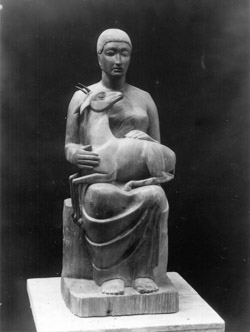 |
Fig. 2 PEK0187
This
wood carving is believed to have been carried out in King’s fifteenth
year. Height: ~75cm
Photo:
Peter King
Copyright:
Estate |
As well as a technical fluency in formal sculpture,
largely self-taught prior to the consolidation of his skills at Wimbledon,
King experimented with many materials, including Perspex stolen from
a nearby factory. He appeared in court as a result, but apparently so
intrigued the factory owner with the account of his technical innovations
with the medium, charges were dropped. King also gained considerable
skill with photography and amongst the surviving artefacts from his
life is an extensive collection of glass plates recording his work.
Figure 3 shows a commission for a school in Surrey, probably made before 1953. This photograph, found
on page 44 of King’s notebook, is captioned in his hand ‘Stone relief
on a Surrey County
Council School
4ft x 5ft’.
[23]
| 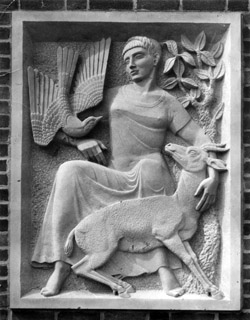 |
Fig. 3 PEK1454
This
photo is found on page 44 of King’s notebook, and is captioned
in his hand ‘Stone relief on a Surrey County Council School 4ft
x 5ft’ Another photo exists of the school building with the relief
in place.
Photo:
Peter King
Copyright:
Estate |
Once King moved into the Abbey Art Centre in 1951 or
1952 he was already pursuing a very personal experimentation and a move
to abstraction. This early period of King’s work was dominated by two
themes: figurative elements taken from ethnic art, and natural elements
as in objet trouvé. By moving into the Abbey Art Centre he came into the
orbit of its founder, Ohly, and his extensive collection of ethnic art
from Africa, Indonesia,
and Tibet. Some of
his collection was on display in a converted tithe barn, an old structure
directly opposite King’s studio. In the existing photographs King’s
studio appears cramped and densely packed with finished and half-finished
works. The photograph in Figure 4 was probably taken between 1951 and
1953, and shows a pair of figures on the left believed to have been
assembled from found branches and timbers taken from an old carriage.
| 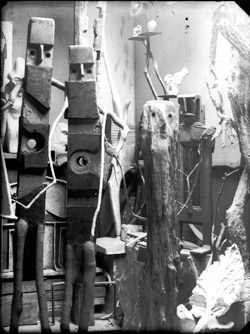 |
Fig.
4
King’s Studio
This
photograph, by King, probably taken between 1951 and 1953, show
both the intensity at which he worked, and the dominant themes
of that period. The pair of figures on the left is believed to
have been assembled from found branches and timbers taken from
an old carriage.
Photo:
Peter King
Copyright:
Estate |
King had already made a journey from his assured classical
mastery to the most experimental of formats, though probably still executing
traditional commissions alongside his new experiments. His instincts
for technical mastery were now often directed at the problems of metal-casting,
using a home-made foundry in the garden of the Abbey Art Centre. He
may have learned the lost-wax casting technique for small-scale sculpture
from Alan Davie, a technique which King now adapted for larger-scale
sculpture. He also used other flammable materials that would be lost
in casting, including a bird’s nest carved into the shape of a face.
Other works of this period provide the bridge between
the overtly experimental and the classical tradition in which he was
so fluent, for example the torso shown in Figure 5. It shows the possible
influence of both Moore and Hepworth.
|
 |
Fig. 5 PEK0059
Torso
in wood, 34 x 74 x 22 (cm)
Photo:
Mike King
Copyright:
Mike King |
The early experiments with found materials and assemblages
gave way to what could be called his mature or ‘middle-period’ style:
sculpture in bronze, aluminium, stone and plaster with a consistent
semi-relief treatment and a personal grammar of semi-geometrical abstraction.
Generally considered to be the iconic piece of this period, and one
of the few works with a name, Man with Cloak appeared on a Gallery One
invitation (fig. 6). Typical of work of this period, the front is worked
in detail, while the back is simply rounded off.
|
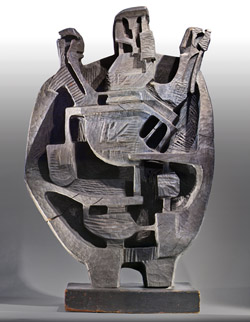 |
Fig.6 PEK0001 (Man with Cloak)
Wood, 59 x 94 x 24 (cm)
Photo:
Mike King
Copyright:
Mike King |
It is not clear why King moved from sculpting in the
round to this semi-relief treatment, but his experience of formal relief
work, and his extensive use of monotypes to explore his emerging sense
of line, may have been factors. In fact he produced huge numbers of
prints, mostly monotypes, of which many hundreds survive, and which
were integral to his artistic development. The monotypes have a strong
sculptural feel, complementing the frontal nature of the sculptures,
and there are a number of examples of close relationships between print
and sculpture. Figure 7 shows a monotype ‘sketch’ for the sculpture
in Figure 8, which was King’s submission for the TUC Congress House sculpture competition in 1955.
[24]
The number in the bottom-right corner may have been
stamped there by competition officials. James Hyman has suggested that
given its close resemblance the print came after the sculpture,
[25]
but there is evidence from other print-sculpture
pairings that it was the other way round.
 |
Fig. 8 PEK0007
Composite
(possibly armature plus painted clay),
52 x 34 x 9 (cm) Entry
for TUC Congress House sculpture competition
Photo:
Mike King Copyright:
Mike King |
Given the apparent convergence between from-the-front
sculpture and in-the-round monotypes of this period, King’s next venture
seems a natural step: to take his sculptural forms and use them in an
animated film. His The Thirteen
Cantos of Hell was an adaptation of part of Dante’s Divine
Comedy, the purgatory section of which seemed to fascinate him.
The technique he used was the shadow-puppet and rostrum technique of
Reiniger, who taught him her methods in exchange for carpentry work
he carried out on her rostrum stand. However her precise role as a possible
mentor in animation is unclear. The Experimental Production Committee
of the British Film Institute gave King a grant of £500 for the film
and it was premiered the Hammer Theatre in May 1956, and shown at the
National Film Theatre, the Edinburgh Festival, Cannes, and other European
galleries. Figure 9 shows a still from the film, featuring a boat motif
that appeared in much of his work of the period. It is poignant, in
the light of his attempt on his life at the time, to note that The Thirteen Cantos of Hell ends with the
‘wood of the suicides’.
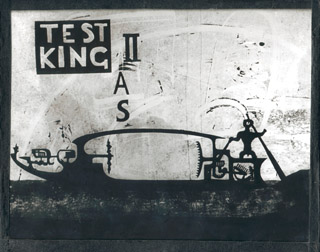 |
Fig. 9 Film still
Film
still, perhaps used in promotional material, from The Thirteen Cantos of Hell
Glass
plate, 24 x 16 (cm)
Photo:
Iby-Jolande Varga
Copyright: Iby-Jolande Varga |
The ‘late’ period of his work seems to veer between
a coherent culmination of his artistic trajectories, and nihilistic
and anguished sculpture and paintings, one of the latter being completed
in his own blood after slashing his wrists.
[26]
His extensive journal entries in this period provide
a picture of a mind on the verge of breakdown: brittle, intensively
creative and profoundly anguished. Loader describes the period as a
mutual exploration of Jung’s psychology and alchemical writings, resulting
in another new direction for King: an illustrated book called The
Ash of Mimir (fig. 12), a little reminiscent of Blake’s illuminated
writings. In King’s notebook there are exercises in calligraphy as a
preparation for this project, and some ruminations on the theme of ‘walking
with a squint’ – seemingly a reference to the way that his surroundings
could overwhelm him, and possibly a reference to Sartre’s Nausea
which had clearly made an impact on him. He also describes suburbia
as the ‘citadel of schizophrenia’, a phrase, it seems, of his own coinage,
but hinting at his state of mind. Two factors seem to have precipitated
this state of mind: firstly the genuine torment over the parting from
his wife and two young children, and secondly the motorcycle accident
in which he broke his leg. He made a poor recovery from this and was
sent for endless and inconclusive medical tests.
Figure 10 is of a painting made in this last period,
one of a series of over a dozen surviving works on paper depicting the
human head in a paroxysm of anguish. These were often painted on the
reverse of earlier monotypes, which, in some cases have been defaced,
presumably by King in moments of anger or depression.
|
 |
Fig. 10 PEK0564
Paint
on paper 56 x 76 (cm)
Photo:
Mike King
Copyright:
Mike King |
His sculpture of the time was sometimes
destructive in both design and execution. This was particularly so of
work executed with a technique he had been working on for some time,
of throwing molten metal into sand, and drawing into sculptural forms
using a refractory implement. Musgrave had described this process as
‘action sculpting’ in a direct reference to Pollock’s action painting.
Sir Anthony Caro mentions that in a visit to the Abbey Art Centre at
this time, where he met Alan Davie and Peter King, he heard of a ‘new
American painter called Jackson Pollock’ and adds that ‘Peter was far
ahead of us all’.
[27]
In a notebook King describes this rather immediate
method of working in metal as follows: they were ‘produced by throwing
the molten metal on a bed of fire-resisting material, and manipulating
the metal before it sets. Each piece so produced is joined to the next
by thrusting the solid form in the molten mass of the next one, so building
up the desired structure’.
[28]
Figure 11 is of an aluminium piece built up in this
way, but including another of his innovations: the addition of molten
glass. This is one of the most considered thrown pieces of this later
period, others seem to be more spontaneous and chaotic.
|
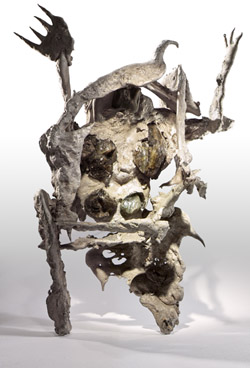 |
Fig. 11 PEK0037
Figure,
aluminium and glass, 24 x 37 x 17 (cm)
Photo:
Mike King
Copyright:
Mike King |
King’s journal
may provide some guidance as to the influences on him,
[29]
though to mine its true significance a longer study
than this is needed. The journal has no dated entries at all, though
some of the books he refers to were only just in print during his last
years, and may help pin down the earliest possible dates for some passages.
A large section of the journal is devoted to a narrative and rather
ironic account of a call up to National Service and subsequent training,
interspersed with reminiscences of cinema attendance and other daily
activities. There are also substantial sections of commentary on art,
philosophy, religion, and psychology, which give us some idea of the
thinkers he had studied. In philosophy, psychology and religion they
were Lao Tse, Meister Eckhart, Henry Thoreau, Sigmund Freud, Jean-Paul
Sartre, C. G. Jung, Martin Buber, Soren Kierkegaard, Martin Heidegger,
Sarvepalli Radhakrishnan, Rudolf Lotze, Nikolai Berdyaev, Emmanuel Mounier,
J. B. Coates, and Edward Glover. It seems that of all these it was Jung
who was the most important to him. In
art history and criticism they were Herbert Read and Lewis Mumford.
The opening pages of the journal record King’s response to Herbert Read’s
The Meaning of Art (1930)
by. King is particularly interested in how distortion of geometric form
works in aesthetics and how the degree of departure is ‘determined by
the individual instinctive expression’.
[30]
At times it appears from the journal that King is embarrassed
to be an intellectual: he ridicules intellectual activity as ‘fonting’.
[31]
It is clear, however, that he must have read widely
from an early age, and to some extent systematically. At the end of
the journal, at a time that may not have been too long before his death,
he had made a monthly reading list, indicating a determination to keep
abreast of new writing in art criticism, literature and philosophy.
Apart from the narrative and commentary sections –
sometimes interleaved – there are also three poems, and an extensive
section towards the end on The
Ash of Mimir (fig. 12). King was clearly obsessed with the Norse legend
of Odin and his attempt to gain wisdom by hanging himself on the Ash
of Mimir, the world-tree, also known as Yggdrasil. King states in the
journal and on the frontispiece of The
Ash of Mimir: ‘The Ash of Mimir may be
defined as that process which will realise those fantasies of Transformation
on Completion of a Journey.’
[32]
It is not clear what King’s sources are for the legend,
though he may have first encountered the myth and its symbolism through
Jung. He cites paragraph 523 from Jung’s Symbols
of Transformation several times.
[33]
The Ash
of Mimir is an unfinished project consisting of five illuminated
pages, twelve additional illustrations, and some twenty-eight journal
pages of supporting text, though more related material may emerge in
time. More work is required on the transcription and interpretation
of these journal pages, but it is clear that King drew on the imagery
of Jean-Paul Sartre’s Nausea in many descriptive passages.
|  |
Fig. 12 PEK0922 Frontispiece for The Ash of Mimir
Ink
and monotype on paper, 20.18 x 29.24 (cm)
Photo:
Mike King
Copyright:
Mike King |
This paper serves to amplify Harrison’s
2003 introduction to Peter King. The real work remains to form any significant
conclusions concerning King’s life and work, to evaluate his place in
British ’50s sculpture. Of the sculpture known to be lost but not necessarily
destroyed there remains the possibility of their discovery, as well
as hitherto unknown works. These may fill some of the gaps and help
in the chronology. The journal and letters need careful cross-referencing
with other accounts of King’s life, such as the written memoirs of his
widow, and oral accounts from others still alive who knew him. A thematic
study is required across the works on paper and the sculpture: once
it is possible, for example, to see all the horse-related representations,
or all the Stygian boats, collected together, much would emerge. King’s
ability to so dramatically distort human proportions while retaining
their integrity is also an issue worth pursuing across the collection:
his personal grammar of human gesture is intimately related to this.
At a purely technical level there are many unanswered questions as to
whether he independently discovered some of the unusual metal-working
techniques he deployed. Finally, the key questions of the influences
on and by him will need to be resolved. As Harrison
says, ‘it is hoped that appropriate recognition for this artist, now
long overdue, will soon be forthcoming’.
[34]
The scholarly work necessary for this recognition
now has significant resources waiting to be explored.
(3726 words)
Acknowledgements
The author would
like to thank the Art and Humanities Research Council (AHRC) for funding
the digitisation project, and London
Metropolitan University
for support. The digitised archive is now online at the Visual Arts
Data Service at vads.ahds.ac.uk/collections/PKA.html and at
www.peterkingsculptor.org.
References
[1]
At the time of
writing there are over a thousand works recorded in the Peter King
archive (available online via the Arts and Humanities Data Service);
over a hundred items of memorabilia that help chart the course of
his life and work; and a number of letters. The known works include
223 works and records of a further 123 that are either lost or destroyed;
618 works on paper; 45 puppets made of hinged card, many of which
are weighted with lead; and two prints of the 16mm film The Thirteen Cantos of Hell. The exact dates of most works are not
known, and he signed almost nothing and gave his pieces no names.
At present they have only four-digit accession numbers. Hence there
remains a considerable task to locate work within precise years and
months, beyond the crude division presented here of four main periods.
[2]
A letter from the Contemporary Arts Society, dated 17
June 1997 states: ‘Further to your enquiry regarding the whereabouts
of work by Peter King, the Contemporary Arts Society purchased the
following work from the artist and presented it to the following museum
collection. Series of Drawings, 1954 … Presented to Birmingham
Museum and Art
Gallery, 1959.’
(Letter in possession of the Estate of Peter King, hereafter Artist’s
estate)
[3]
Starting with a mention in Roger Berthoud’s Life of
Henry Moore (1987). This is now found in the revised edition:
Berthoud, R., The Life of Henry
Moore, London: Giles de la Mare
Publishers, 2003, p. 303
[4]
Wedd, K., et al, Creative
Quarters – The Art World in London
from 1700 to 2000, Museum
of London: Merrell,
2001, p. 135
[5]
Barker, I., Anthony Caro – Quest for the New Sculpture,
Kunzelsau: Swiridoff Verlag, 2004
[6]
Mitchinson, D., et al, Hoglands – The Home of Henry and Irina Moore, Aldershot:
Lund Humphries, 2007, pp. 73, 77, 90
[7]
Curtis, P., et al, Sculpture
in 20th-century Britain
Vol 2, Leeds: Henry Moore Institute,
2003, pp. 191-193
[8]
Recent shows include: Museum of London, ‘Creative Quarters’,
June-July 2001; Henry Moore Institute, Leeds, ‘Sculpture in 20th Century
Britain’, September 2003-March 2004; Modern British Artists, 20/21
British Art Fair, London, September 2006; Robin Katz Gallery, May-July
2007; Henry Moore Institute Library, Leeds, November 2007-January
2008; England and Co. Retrospective, March-April 2008; Abbey Art Centre,
July 2008; British Museum, ‘British Sculptors’ Drawings’ from September
2008 to January 2009. Planned shows include Jonathan Clarke Fine Art,
London, the Lotte
Reiniger Museum,
Tübingen, Germany,
and a second solo show at England and Co.
[9]
Wedd, Kit, et al, Creative Quarters – The Art World in
London from 1700 to 2000, (Museum
of London) London: Merrell, 2001, p. 135
[10]
Robert Adams, Kenneth Armitage, Reg Butler, Lynn Chadwick,
Geoffrey Clarke, Bernard Meadows, Eduardo Paolozzi and William Turnbull.
[11]
Letter from Frank Martin to Liz Sheppard, dated 26 February
1985; Henry Moore Institute Archive, Leeds
[12]
Barker, as at note 5, p. 50
[13]
King cast Caro’s Woman
Walking Along and Acrobatic
Figure, 1951-55, Barker, Ian, Antony
Caro: Quest for the New Sculpture, Kunzelsau: Swiridoff Verlag,
2004, p. 59
[15]
The film is in the BFI Archive, London .
[16]
The Times,
5 November 1957
[17]
Letter from Caro to King’s widow, dated 1 November 1957,
in Henry Moore Institute, Leeds,
archive.
[18]
In 1993 George Melly wrote to King’s widow that he was
impressed with photos of the work she had sent to him, letter to Katharine
King, 29 March 1993, Artist’s estate
[19]
Some letters are in the Henry Moore Foundation Archive
at Much Hadham, others in the Artist’s estate
[20]
This claim is made by King’s brother, but the only other
evidence for this might be in King’s journal writings which bear a
resemblance at times to Jean-Paul Sartre’s Nausea,
alleged by Simone de Beauvoir to have been written after a bad mescaline
trip.
[21]
Art News, February
1955, Vol. 53, No. 10, p. 68
[22]
Harrison, M., ‘Peter
King’ in Curtis, as at note 7, p. 191
[23]
Another photograph exists of the school building with
the relief in place, in notebook; artist’s estate.
[24]
As is well known the commission eventually went to Jacob
Epstein and Bernard Meadows.
[25]
Private conversation.
[26]
Conflicting accounts of this event exist.
[27]
Private correspondence, 9 April 1997. See also Barker,
as at note 11
[28]
King, journal,
p. 14; Artist’s estate
[29]
The Peter King Estate is indebted to Betty MacAlister
and Jackie Howson at the Henry Moore Institute, Leeds
for the transcription of the journal.
[30]
King, journal, p. 1; Read, Herbert, The Meaning of Art, London: Faber and Faber, 1972, pp 28-32
[31]
A creature that intellectualises as a pastime is ridiculed
by King as a ‘glub of font’ and compared to a grotesque insect that
carries a huge egg sac around with it: King, journal, p. 77
[32]
King, journal,
p. 98
[34]
Harrison, as at note
7, p. 193
|
|



